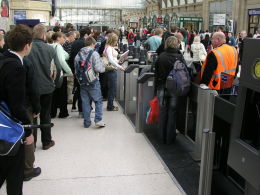Posted 1st February 2011 | 5 Comments
Rail travel figures rival the 1920s, says ATOC

NEW figures from the Association of Train Operating Companies suggest that the growth in railway passenger traffic has resumed with a vengeance, after the recent slowdown caused by the financial crisis of 2008-09.
ATOC said 1.32 billion passenger journeys were made on the National Rail network in the calendar year 2010 – a rise of 6.9 per cent compared with 2009 and 37 per cent more than in 2000 – and claimed that the total was now approaching a peacetime record, with such totals not having been seen since the last peak, in the early 1920s.
The number of passenger kilometres rose to 53.58 billion last year, compared with 51.1 billion in the year ending March 2010, as reported by the Office of Rail Regulation.
ATOC said that the latest growth was partly driven by people taking advantage of cheap tickets. Sales of deeply discounted Advance tickets rose by 12 per cent compared to 2009, and the average price paid for a single journey actually fell slightly – from £5.00 to £4.96.
Railnews sources show that the total for 1923 was 1.319 billion, but that the total fell after that and did not reach 1.3 billion again except in World War 2.
However, comparisons need to be made with care, because ATOC told Railnews that it used the ‘post-allocation dataset’ produced by the Rail Settlement Plan database LENNON, which is used to allocate revenue to train operators but has the side effect of inflating the reported total by about five per cent, according to the ORR.
Even if the real figure for 2010 is closer to 1.25 billion, this is still higher than in most peacetime years before World War 2, and was never achieved in the nationalisation period between 1948 and 1997.
The proportion of season ticket holders is higher than it was 90 years ago. In 1922, just over a third of passengers were using season tickets, but now that proportion is approaching half.
Because the network is only about half its former size, following the closures which occurred mainly between 1950 and 1970, each track kilometre is now much busier, on average, than ever before.
Railway analysts are questioning whether this trend can continue following the increase in fares last month, which averaged 6.2 per cent.
Reader Comments:
Views expressed in submitted comments are that of the author, and not necessarily shared by Railnews.

Rob, West Yorkshire
I have bought three single tickets before for each leg of a return journey. Is this 6 journeys in total even though only one return trip?
Joe Grey, Folkestone
Interesting that growth has recommenced despite the recession.
Of course the population has grown by about 40% since the 1920\'s, so \'rail journeys per capita\' is still considerably down since the 1920\'s whilst road journeys are many times higher.
Craig Ward, BLACKBURN, UK
If you add in the massive numbers evading paying their fares then the figure would be even higher. I suspect that revenue protection and honesty were greater in the 1920's,
AC, Manchester
Yes but on half the track they had then. It must be so crowded.
David Faircloth, Derby, UK
How is this figure calculated?
As an example, in 2009 four of us made a return journey (ie., eight single journeys), but - to save cost - we had two tickets for each trip (sixteen tickets in all); splitting the tickets at the point at which we changed trains. There's no way of any system knowing that we did this (and it isn't the first time I've done it), so how is it reflected in ATOC's figures?
I'm not unique in doing this, so the actual number of journeys made could be considerably less than ATOC's figure if it is calculated from tickets sold.